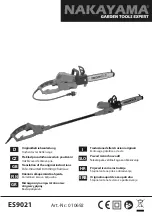
7
WARNING
Keep hands out of the No
ADJUSTMENTS
WARNING
Alw
before
ays remo
changing
ve the b
accessories
attery pack
or
making adjustments. Do not defeat the guards.
No Hand Zone
a safe distance from the blade.
No Hand Zone Indicators:
Hands Zone at all times
during use. Contact with blade will result
in serious injury.
If your hand is placed too close to the saw blade, there
is an increased risk of injury from blade contact. Use
the No Hand Zone indicators to ensure hands are kept
• No Hands Zone Circle (groove around turntable)
• Fence Hand Holds (notches on top of fences)
• Hand Stops (used when fence is removed)
either in front or behind the saw blade. The proximity
Never cross your hand over the intended line of cutting
obvious and you may be seriously injured. Saw head
of the spinning saw blade to your hand may not be
may slide/move, putting your safety at risk. Always
wait for the blade to stop completely before raising
the head, moving workpiece or changing settings.
Select the Workpiece Carefully
Be cautious of pitchy, knotty, wet or warped work-
pieces. These materials are likely to create pinching
conditions. Workpieces that bow and pinch may
result in kick back. Inspect for and remove nails
before cutting. Always keep blades clean and sharp;
otherwise the blade produces a narrow kerf and is
likely to be pinched by the workpiece. This tool is not
recommended for cutting ferrous metals such as iron
and steel. See Applications for a more complete list
of materials that can be cut.
Support the Workpiece Properly
Always support the workpiece during operation.
Otherwise, the workpiece may pull up and into the
saw.
1.
2.
Use the workpiece clamp:
Clamp the workpiece
to the table with the included clamp. The clamp
can be moved to either side of the table.
a. Insert the clamp bar into either clamp socket
behind the fences.
b. Turn the clamp bar until it seats fully into the
socket.
c. Rotate the clamp around so the screw is above
the table.
d. Tighten the clamp screw to secure the work-
piece to the table.
3.
Use a C-clamp:
Clamp the workpiece to the fence
with a C-clamp.
Support of Longer Workpieces
Adjusting the Mitre Angle
Detent lever
Detent override knob
Mitre lock lever
Adjusting the Bevel Angle
The bevel can be adjusted to any angle from 0° to 48°,
left or right.
1. Remove battery pack.
2. Lift up the mitre lock lever to release the turntable.
3. Lift the detent lever and rotate the turntable to the
detent angle closest to the desired angle.
a. Lift the detent lever.
b. Rotate the detent override knob forward.
c. Rotate the turntable to the exact angle.
5. Press down the mitre lock lever to lock the adjust-
ment in place and avoid shifting during use.
Bevel
knob
bevel stop allows
for 22.5°. The low-
1. Remove battery pack.
2. Loosen the bevel knob.
3. Tilt the saw head to the desired angle.
NOTE:
To overcome the 0° stop, hold the saw
head left of 0°, then pull out the 0° stop pin and
tilt the saw head to the desired angle.
4. Tighten the bevel knob securely to lock the bevel
adjustment in place.
5. For precise angles
(22.5°, 33.9°, or
30.0°), position the
desired engraved
bevel stop accord-
ingly. The upper
er bevel stop al-
lows for 33.9° and
30.0° on reverse
Bevel stops
sides. To access
the 30.0° bevel stop, using the long end of the on-
board allen tool, remove the 22.5° bevel stop, then
Longer workpieces need support along their full
length. If you are using the saw on a level work
bench, prop up the workpiece to a height of 76 mm
(3”) ((2) 50 mm x 101 mm (2”x 4”) stacked flat) from
the bottom of the saw feet. There are also many
aftermarket work tables specifically designed for
mitre saws that provide supports for all types of
workpieces.
4. To make a fine adjustment to the mitre angle:
The mitre angle can be set using detents for
commonly cut angles (0°, 15°, 22.5° 31.6°, and
45°), as well as finely adjusted to any angle to
compensate for a custom situation.
remove the lower bevel stop and flip until the
30.0° engraving is facing up. Secure the lower
bevel stop before proceeding. Remember to
reinstall the 22.5° bevel stop when finished.
Use clamps to support the
workpiece whenever possible to
WARNING
keep hands far from the blade. Do not use this saw
to cut pieces that are held by hand or too small to be
securely clamped.
Keep hands out of the No Hands
Zone at all times during use. Use
WARNING
the fence hand holds to ensure your hands do not
enter the No Hands Zone.
Use the Fence:
Hold the workpiece flush against
the fench to provide a straight path for the saw
blade. This will help eliminate the tendency for the
blade teeth to bind. The fence can be used as a
support for mitre, bevel and compound cuts.






























